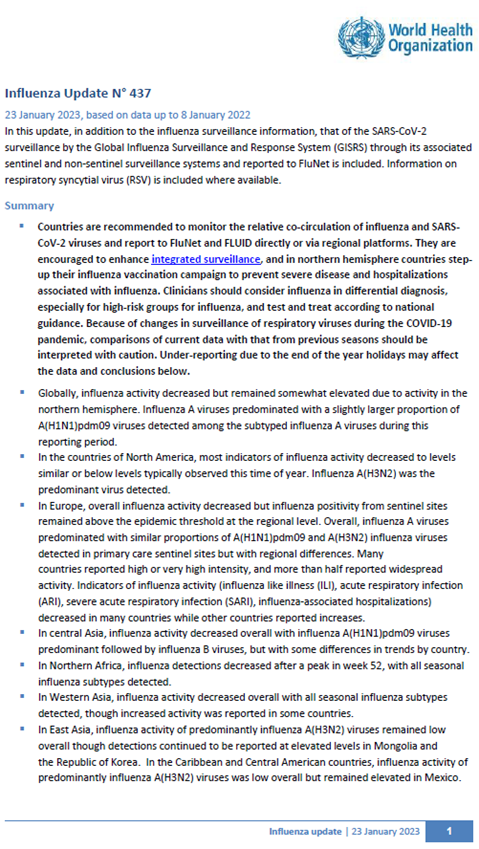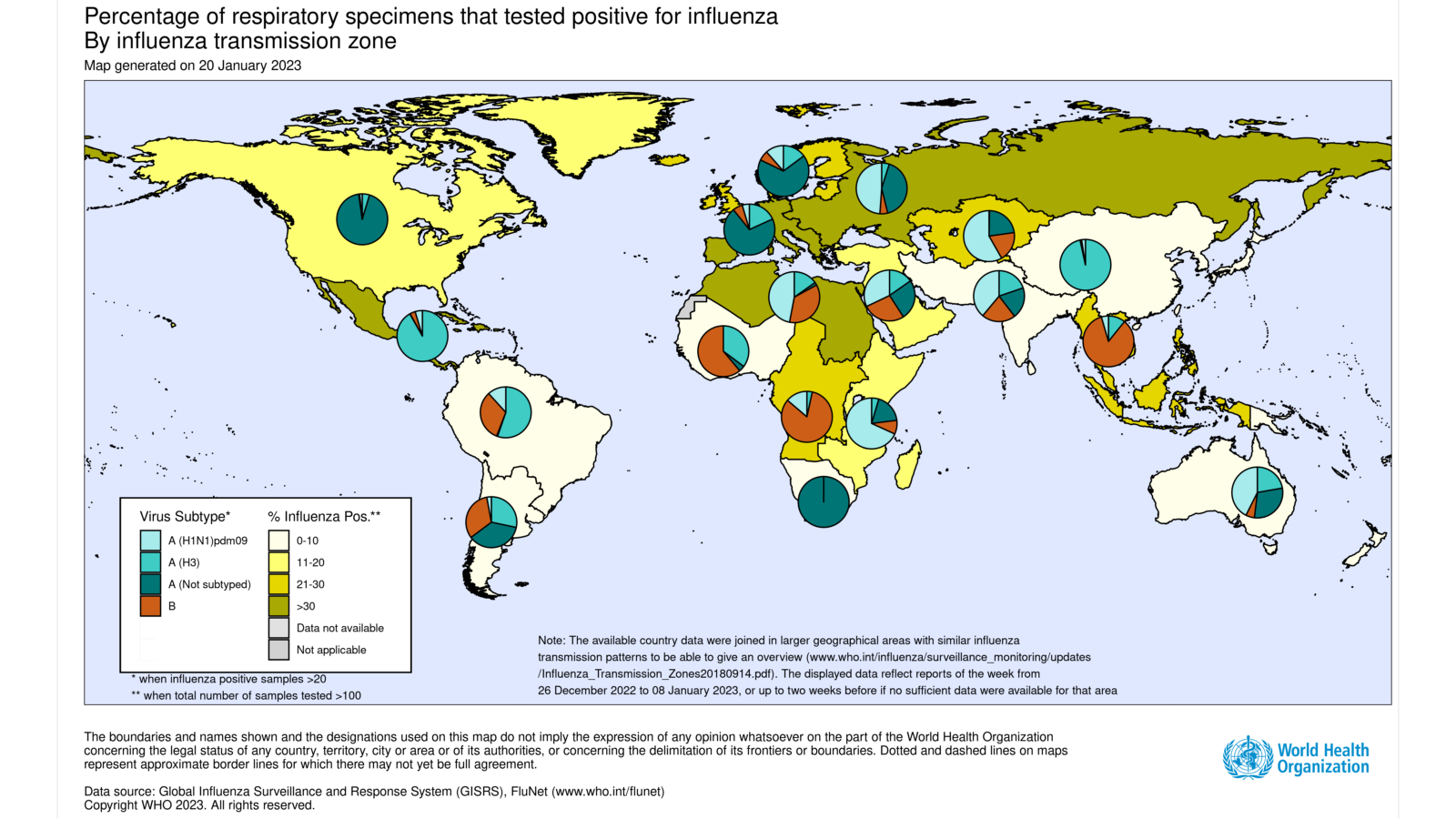Influenza Update N° 437

Overview
23 January 2023, based on data up to 8 January 2023
Information in this report is categorized by influenza transmission zones, which are geographical groups of countries, areas or territories with similar influenza transmission patterns. For more information on influenza transmission zones, see the link below:
Influenza Transmission Zones (pdf, 659kb)
- Countries are recommended to monitor the co-circulation of influenza and SARS-CoV-2 viruses. They are encouraged to enhance integrated surveillance and in northern hemisphere countries step-up their influenza vaccination campaign to prevent severe disease and hospitalizations associated with influenza. Clinicians should consider influenza in differential diagnosis, especially for high-risk groups for influenza, and test and treat according to national guidance. Because of changes in surveillance of respiratory viruses during the COVID-19 pandemic, comparisons of current data with that from previous seasons may not always be valid and data should be interpreted with caution. Under-reporting due to the end of the year holidays may affect the data and conclusions below.
- Globally, influenza activity decreased but remained somewhat elevated due to activity in the northern hemisphere. Influenza A viruses predominated with a slightly larger proportion of A(H1N1)pdm09 viruses detected among the subtyped influenza A viruses during this reporting period.
- In the countries of North America, most indicators of influenza activity decreased to levels similar or below levels typically observed this time of year. Influenza A(H3N2) was the predominant virus detected.
- In Europe, overall influenza activity decreased but influenza positivity from sentinel sites remained above the epidemic threshold at the regional level. Overall, influenza A viruses predominated with similar proportions of A(H1N1)pdm09 and A(H3N2) influenza viruses detected in primary care sentinel sites but with regional differences. Many countries reported high or very high intensity, and more than half reported widespread activity. Indicators of influenza activity (influenza like illness (ILI), acute respiratory infection (ARI), severe acute respiratory infection (SARI), influenza-associated hospitalizations) decreased in many countries while other countries reported increases.
- In central Asia, influenza activity decreased overall with influenza A(H1N1)pdm09 viruses predominant followed by influenza B viruses, but with some differences in trends by country.
- In Northern Africa, influenza detections decreased after a peak in week 52, with all seasonal influenza subtypes detected.
- In Western Asia, influenza activity decreased overall with all seasonal influenza subtypes detected, though increased activity was reported in some countries.
- In East Asia, influenza activity of predominantly influenza A(H3N2) viruses remained low overall though detections continued to be reported at elevated levels in Mongolia and the Republic of Korea. In the Caribbean and Central American countries, influenza activity of predominantly influenza A(H3N2) viruses was low overall but remained elevated in Mexico.
- In the tropical countries of South America, influenza detections were generally low, and influenza A(H3N2) and influenza B viruses predominated. Influenza positivity was at a moderate level in Ecuador.
- In tropical Africa, influenza activity was highest in eastern Africa but remained low overall with detections of all seasonal influenza subtypes reported.
- In Southern Asia, influenza activity was low and continued to decrease with influenza A(H1N1)pdm09 predominant and influenza A(H3N2) and influenza B also reported.
- In South-East Asia, detections of predominantly influenza B remained elevated due to continued detections reported in Malaysia.
- In the temperate zones of the southern hemisphere, influenza activity decreased to low levels.
- National Influenza Centres (NICs) and other national influenza laboratories from 122 countries, areas or territories reported data to FluNet for the time period from 26 December 2022 to 08 January 2023 * (data as of 2023-01-20 07:54:19 UTC). The WHO GISRS laboratories tested more than 563 948 specimens during that time period. 84 596 were positive for influenza viruses, of which 79 268 (93.7%) were typed as influenza A and 5328 (6.3%) as influenza B. Of the subtyped influenza A viruses, 8225 (51.9%) were influenza A(H1N1)pdm09 and 7621 (48.1%) were influenza A(H3N2). Of the type B viruses for which lineage was determined, all 394 (100%) belonged to the B/Victoria lineage.

- SARS-CoV-2 positivity from sentinel surveillance decreased globally, with a particularly sharp decrease in the WHO Region of the Americas where positivity decreased from over 30% to just above 20%. In the Western Pacific Region, positivity decreased very slightly and remained around 20%. Activity remained under 10% in the other regions. SARS-CoV-2 positivity from non-sentinel surveillance decreased significantly in the Region of the Americas and the Western Pacific region to approximately 20% and 10% respectively, but increased in the African region to 15%.
- During the COVID-19 pandemic, WHO encourages countries, especially those that have received the multiplex influenza and SARS-CoV-2 reagent kits from GISRS, to conduct integrated surveillance of influenza and SARS-CoV-2 and report epidemiological and laboratory information in a timely manner to established regional and global platforms. The guidance can be found here: https://covid.comesa.int/publications/i/item/WHO-2019-nCoV-integrated_sentinel_surveillance-2022.1.
- National Influenza Centres (NICs) and other national influenza laboratories from 72 countries, areas or territories from six WHO regions (African Region: 10; Region of the Americas: 16; Eastern Mediterranean Region: 5; European Region: 34; South-East Asia Region: 3; Western Pacific Region: 4) reported to FluNet from sentinel surveillance sites for time period from 26 December 2022 to 08 January 2023* (data as of 2023-01-20 07:54:19 UTC). The WHO GISRS laboratories tested more than 21 831 sentinel specimens during that time period and 3737 (17.1%) were positive for SARS-CoV-2. Additionally, more than 274 346 non-sentinel or undefined reporting source samples were tested in the same period and 98 045 were positive for SARS-CoV-2.
Source of data
______________________________________________________________________________________________
The Global Influenza Programme monitors influenza activity worldwide and publishes an update every two weeks. The updates are based on available epidemiological and virological data sources, including FluNet (reported by the WHO Global Influenza Surveillance and Response System), FluID (epidemiological data reported by national focal points) and influenza reports from WHO Regional Offices and Member States. Completeness can vary among updates due to availability and quality of data available at the time when the update is developed.
*It includes data only from countries reporting on positive and negative influenza specimens.
